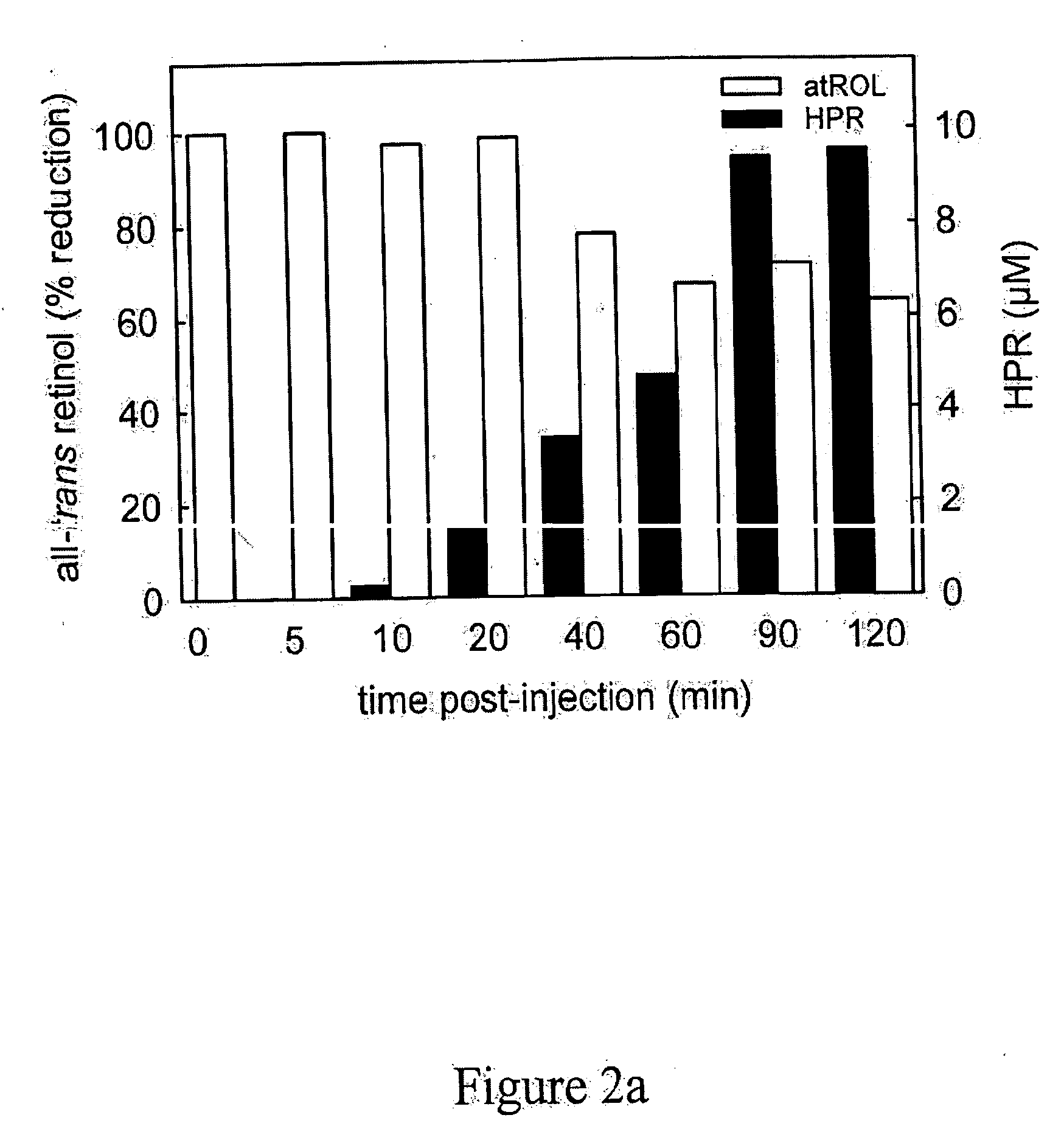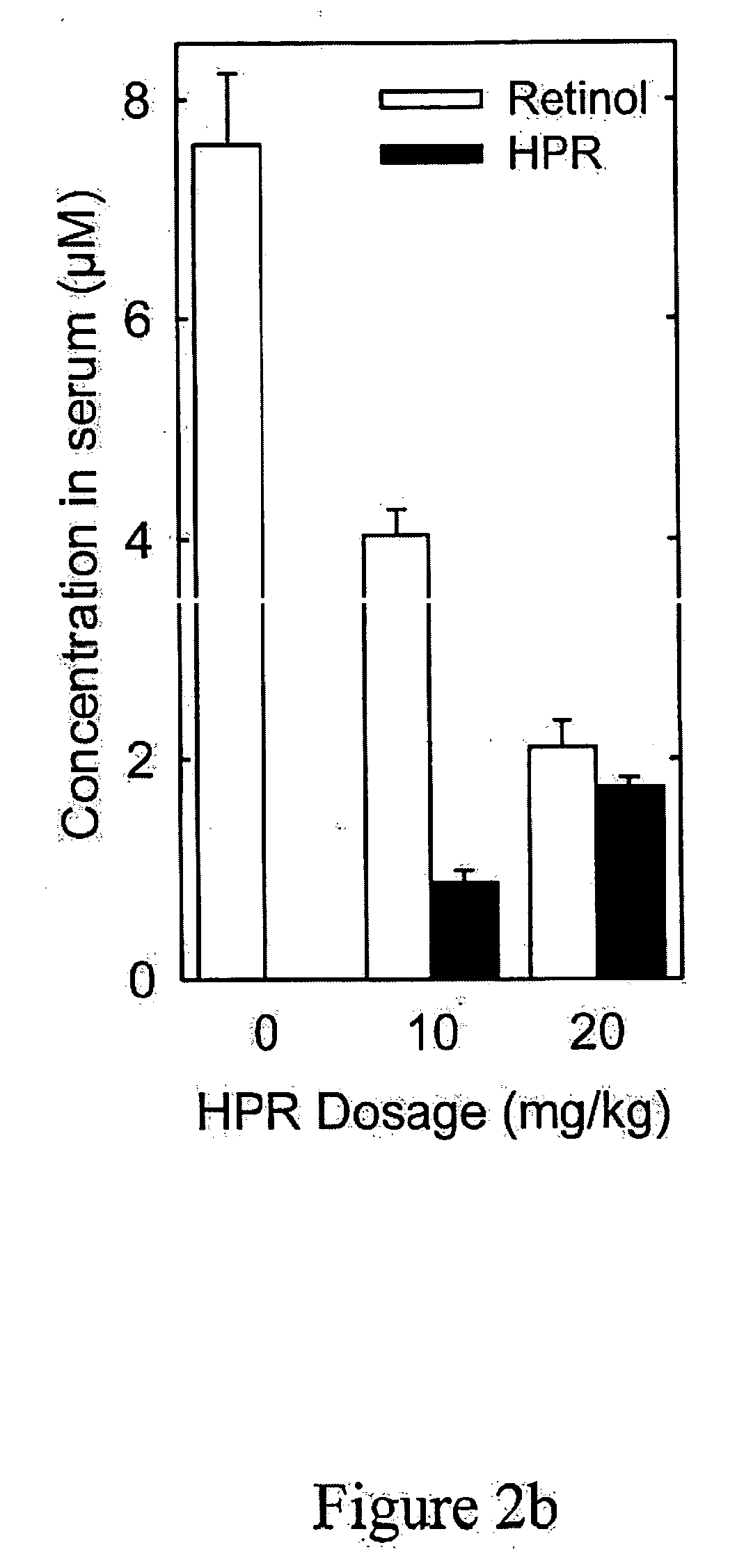Methods and compositions for treating ophthalmic conditions with retinyl derivatives
a technology of retinyl derivatives and ophthalmic conditions, applied in the field of ophthalmic conditions treatment, can solve the problems of drusen under the macula, adverse effects, and production of lipofuscin
- Summary
- Abstract
- Description
- Claims
- Application Information
AI Technical Summary
Benefits of technology
Problems solved by technology
Method used
Image
Examples
example 1
Testing for the Efficacy of Compounds of Formula (I) to Treat Macular Degeneration
[0242] For pre-testing, all human patients undergo a routine ophthalmologic examination including fluorescein angiography, measurement of visual acuity, electrophysiologic parameters and biochemical and rheologic parameters. Inclusion criteria are as follows: visual acuity between 20 / 160 and 20 / 32 in at least one eye and signs of AMD such as drusen, areolar atrophy, pigment clumping, pigment epithelium detachment, or subretinal neovascularization. Patients that are pregnant or actively breast-feeding children are excluded from the study.
[0243] Two hundred human patients diagnosed with macular degeneration, or who have progressive formations of A2E, lipofuscin, or drusen in their eyes are divided into a control group of about 100 patients and an experimental group of 100 patients. Fenretinide is administered to the experimental group on a daily basis. A placebo is administered to the control group in ...
example 2
Testing for the Efficacy of Compounds of Formula (I) to Reduce A2E Production
[0250] The same protocol design, including pre-testing, administration, dosing and toxicity evaluation protocols, that are described in Example 1 are also used to test for the efficacy of compounds of Formula (I) in reducing or otherwise limiting the production of A2E in the eye of a patient.
[0251] Methods for measuring or monitoring formation of A2E include the use of autofluorescence measurements of N-retinylidene-phosphatidylethanolamine, dihydro-N-retinylidene-N-retinyl-phosphatidylethanolamine, N-retinylidene-N-retinyl-phosphatidylethanolamine, dihydro-N-retinylidene-N-retinyl-ethanolamine, and / or N-retinylidene-phosphatidylethanolamine in the eye of the patient. Autofluorescence is measured using a variety of equipment, including but not limited to a confocal scanning laser ophthalmoscope, see Bindewald, et al., Am. J. Ophthalmol., 137:556-8 (2004), or the autofluorescence or absorption spectra meas...
example 3
Testing for the Efficacy of Compounds of Formula (I) to Reduce Lipofuscin Production
[0252] The same protocol design, including pre-testing, administration, dosing and toxicity evaluation protocols that are described in Example 1 are also used to test for the efficacy of compounds of Formula (I) in reducing or otherwise limiting the production of lipofuscin in the eye of a patient. The statistical analyses described in Example 1 may also be employed.
[0253] Tests that can be used as surrogate markers for the efficacy of a particular treatment include the use of visual acuity and visual field examinations, reading speed and / or reading acuity examinations, measurements on the size and number of scotoma and / or geographic atrophic lesions, and the measuring / monitoring of autofluorescence of certain compounds in the eye of the patient, as described in Example 1.
PUM
| Property | Measurement | Unit |
|---|---|---|
| Time | aaaaa | aaaaa |
| Time | aaaaa | aaaaa |
| Pharmaceutically acceptable | aaaaa | aaaaa |
Abstract
Description
Claims
Application Information
 Login to View More
Login to View More - R&D
- Intellectual Property
- Life Sciences
- Materials
- Tech Scout
- Unparalleled Data Quality
- Higher Quality Content
- 60% Fewer Hallucinations
Browse by: Latest US Patents, China's latest patents, Technical Efficacy Thesaurus, Application Domain, Technology Topic, Popular Technical Reports.
© 2025 PatSnap. All rights reserved.Legal|Privacy policy|Modern Slavery Act Transparency Statement|Sitemap|About US| Contact US: help@patsnap.com



